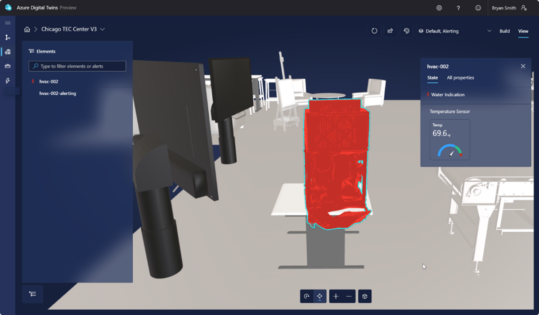In today’s competitive manufacturing landscape, minimizing downtime and maximizing productivity are essential for success. Azure Digital Twins and the Internet of Things (IoT) provide an innovative solution, enabling manufacturers to transition from predictive maintenance—anticipating when failures might occur—to proactive optimization, where operations are continuously refined for peak performance. This powerful combination not only prevents equipment failures but also streamlines processes, boosting efficiency and delivering measurable value to manufacturing businesses.
This post examines how Azure Digital Twins and IoT revolutionize manufacturing by enabling real-time data collection, advanced simulations, and continuous optimization. We’ll delve into the transformative power of predictive maintenance, the shift to proactive optimization, and the pivotal role these technologies play in shaping the future of smart manufacturing.
The Next Generation of Predictive Maintenance
Predictive maintenance uses advanced analytics and real-time data to forecast equipment failures before they happen, helping manufacturers stay ahead of disruptions. This approach is vital in manufacturing, where even brief periods of unplanned downtime can lead to significant productivity losses, increased operational costs, and potential damage to critical machinery.
Azure Digital Twins elevate predictive maintenance by creating virtual models of physical assets that reflect their real-time status. These dynamic digital replicas empower manufacturers to anticipate equipment failures, optimize performance, and make data-driven decisions with confidence. By preventing unplanned shutdowns, extending asset lifespans, and reducing maintenance costs, this technology delivers significant operational and financial benefits for manufacturing clients.
How to Use Azure Digital Twins and IoT for Predictive Maintenance and Proactive Optimization
Step 1: Integrating IoT devices for data collection
The first step involves configuring your IoT devices and deploying them in the Azure IoT ecosystem to seamlessly collect data on critical manufacturing equipment.
- Install and Configure IoT Sensors: Begin by strategically placing IoT sensors that monitor key metrics such as vibration, temperature, and pressure on essential machinery. These sensors gather real-time data to provide insights into equipment health.
- Utilize Azure IoT Hub: Leverage Azure IoT Hub for managing and orchestrating data streams from the sensors. The IoT Hub ensures secure bi-directional communication between your devices and the cloud, enabling reliable data transfer.
- Sensor Data Intelligence (SDI): D365 Supply Chain Management users can implement SDI to enhance the data collection process. It simplifies the integration of sensor data into your existing Microsoft ERP system, allowing for a smoother transition to digital operations. SDI supports quick deployment of IoT solutions on Azure, streamlining the setup process for manufacturers.
Step 2: Creating digital twins of manufacturing assets
After establishing your IoT infrastructure, the next step is to create Azure Digital Twins, which are virtual representations of your physical assets.
- Building Digital Twins: Use pre-built models from Azure or customize them to accurately reflect your specific equipment. This modeling enables precise simulations of machine behavior and operational parameters, helping manufacturers predict and prevent potential issues.
- Integrate Real-Time Data: Ensure that the digital twins continuously receive real-time data from IoT sensors. This integration creates a dynamic and constantly updated representation of the physical asset, providing actionable insights into performance and enabling informed decision-making.

Azure interface
Step 3: Implementing Predictive Maintenance Algorithms
With digital twins and IoT data in place, predictive maintenance becomes achievable through advanced analytics:
- Train Predictive Models: Leverage machine learning algorithms to analyze both historical and real-time data. By identifying patterns in equipment performance and failures, you can forecast maintenance needs with precision, reducing unexpected disruptions.
- Anomaly Detection: Configure alerts to flag anomalies detected by your predictive models. This proactive strategy enables manufacturers to address potential issues early, minimizing costly unplanned downtime.
- Azure Machine Learning: Harness Azure Machine Learning services to build and deploy predictive models. This seamless integration empowers you to make data-driven maintenance decisions, ensuring operational efficiency and reliability.
Step 4: Proactive optimization through real-time simulations
Once predictive maintenance is operational, use the digital twin to implement proactive optimization strategies:
- Running Real-Time Simulations: Leverage the insights from Azure Digital Twins to run simulations that test various production scenarios in real time. These simulations help identify the most efficient workflows, machine settings, and resource allocations to optimize overall performance.
- Optimizing Production Processes: Based on simulation results, fine-tune machine parameters to enhance energy efficiency, maximize output, and reduce operational costs. This step ensures a sustainable balance between production demands and resource utilization.
- Integrating 3D Scenes: Use Azure’s 3D Scenes Studio to visualize your manufacturing environment in three dimensions. This immersive tool enables better decision-making by providing real-time, actionable insights to identify and address operational inefficiencies.

Azure Digital Twins
How This Technology Benefits Manufacturers
For manufacturers, the integration of Azure Digital Twins and IoT drives significant operational improvements, including:
- Reduced Downtime: Predictive maintenance enables manufacturers to perform maintenance only when necessary, preventing unexpected breakdowns and minimizing operational disruptions.
- Enhanced Productivity: By fine-tuning machine settings and optimizing production workflows, manufacturers can boost output without increasing energy consumption or accelerating wear and tear on equipment.
- Cost Savings: Accurate predictions and streamlined operations reduce maintenance costs, lower energy usage, and prevent expensive repairs associated with unexpected equipment failures.
Tips for Implementing Digital Twins and IoT in Manufacturing
- Start Small: Focus on one machine or process to test and refine before scaling across your production line. This minimizes risks and ensures success.
- Prioritize Data Accuracy: Regularly calibrate sensors to collect reliable data, which forms the foundation for informed decisions.
- Commit to Continuous Improvement: Keep digital twin models up to date to reflect physical system changes and improve performance over time.
Conclusion
Azure Digital Twins and IoT are revolutionizing how manufacturers approach maintenance and optimization. For RSM’s manufacturing clients, these cutting-edge technologies pave the way for reduced downtime, cost savings, and boosted productivity. By adopting these tools, manufacturers can transition to smarter, more efficient operations built for the future. Learn more about tools we provide for manufacturers here.
Ready to take your manufacturing processes to the next level? RSM is here to help. Contact us today to discover how we’re driving transformation for our clients with Azure Digital Twins and IoT.

 RSMUS.com
RSMUS.com
